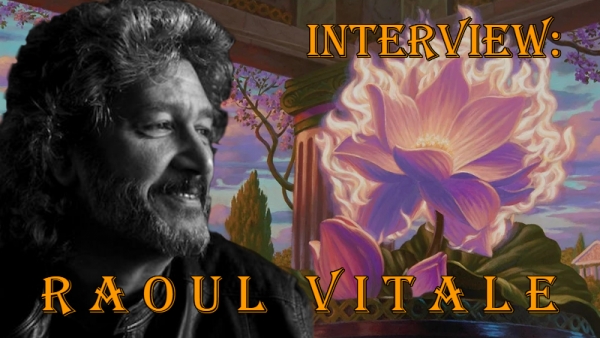Magic: The Gathering artist Raoul Vitale joins Magic Untapped for a Q&A.
Since the early 1990s, Raoul Vitale has been creating art professionally. Starting off as a stained glass designer, Vitale went more and more into illustrations. In 2012, Wizards of the Coast came knocking. Or, rather, he knocked first, kicking off a tenure as a Magic: The Gathering artist that has lasted 10 years and counting.
Vitale took some time out of his busy schedule to chat with Magic Untapped about his history as an artist, rocks, Victorian-era art, and the Mox Pearl.
Magic Untapped: What inspirations and influences in your life drove you to becoming a professional artist?
Raoul Vitale: I don’t remember a time in my life when I didn’t draw, so since I was somewhat obsessed with art, I almost didn’t have a choice - especially since I have no other skills. As a teenager, my influences were 19th century art and illustration. By the time I was in high school, I discovered the illustrations of the Brothers Hildebrandt and that discovery cemented the idea that I had to pursue illustration.
MU: How did you get into doing artwork for Magic: The Gathering? Did you reach out to Wizards of the Coast or did they reach out to you?
RV: I contacted Jeremy Jarvis and he responded within minutes with my first MTG assignment, which was from Return to Ravnica, in 2012.
MU: Your first pieces for Magic: The Gathering were the cluestones in the Return to Ravnica block. How do you feel your artwork for the game has evolved since then?
RV: For me, working on Magic in the first year or so was fraught with insecurity. I assumed that since the images were going to be reproduced so small that they had to be kept simple and that I had to strictly adhere to the description and suggestions. Both were wrong. My illustrator friends who had been working in Magic were putting out insanely complex and dynamic pieces. My main problem has been to do "what I think they want to see” versus trusting that my own vision will be well received. These days I’ve been approaching most assignments as if they are personal pieces and I think it’s getting better.
MU: You’ve done the artwork on dozens of Magic cards so far. Which of your cards have been your favorites and what is it about them that makes them stand out?
RV: Sometimes an art director will see one subject you’ve done and then tend to give you more of the same. For a while I was the ‘rock’ guy - gemstones and the like, since I had done five Mox prize pieces. While doing [Return to] Ravnica I did a Goblin piece that I was happy with, mainly because the color worked out nicely. I still like the Theros lands and
a few non specific cards from that time. I like most of the nine prize pieces I’ve done because I had a bit more time and could give them more thought.
MU: Illustrating Magic cards is only one small part of what you do overall as an artist with so many other projects and commissions. What are some of the non-Magic projects you’re most proud of and what do you have on the horizon whether that be illustrating new Magic cards or something else?
RV: I’ve done quite a lot of private commissions for collectors and most of them worked out well, although there are always ways to improve an image. I enjoy doing them for the freedom they afford and because there are no time constraints. I have opportunity to develop the initial drawing leisurely and to make adjustments after days of not looking at it - which you don’t get to do with commercial work, especially if you’re a traditional, or in my case a painfully traditional, artist. I do have a few new MTG pieces that came together well and I always look forward to the next, hoping and trying to do better.
MU: Has there ever been any unusual art requests you have been given for a card, or a card where there was little description on what was wanted?
RV: The best example was for my first prize piece, the Mox Pearl. The description read: "Show a white pearl floating above a blocky white pedestal in a white temple with a view of white sand outside an open window." Instant anxiety! I don’t know anything about the game, but my initial thought was that the pearl should be an object of reverence. So in an attempt to dress up this description, I put the pearl flanked by two winged bronze lions and hoped that it would help. With a distinct play of light and shadow, I was able to introduce other colors while keeping to the description. Every Mox after that had a similar prompt. The colors just changed.
MU: What is the most challenging color to make art for?
RV: So far, I haven’t really had a problem with the five colors.
MU: Was there ever any artwork that couldn't have been used because of a card being tested out or otherwise?
RV: My very first piece for [Return to] Ravnica was never printed. It was among my favorites. Another was also from Ravnica: a Gruul pit fight. Don’t know why they were never used.
MU: What kinds of things are more tricky for you to create (landscapes, people creatures, etc.)?
RV: I tend to favor organic forms over straight lines, so architecture is very tedious for me. I recently painted a scene that was mainly buildings and it took me twice as long to do than people, creatures or landscapes. I really enjoy inventing creatures! I only got to do that once for a card called Hunt the Weak.
I’m hoping for future opportunities.
Thank you to Raoul for participating in this interview.









